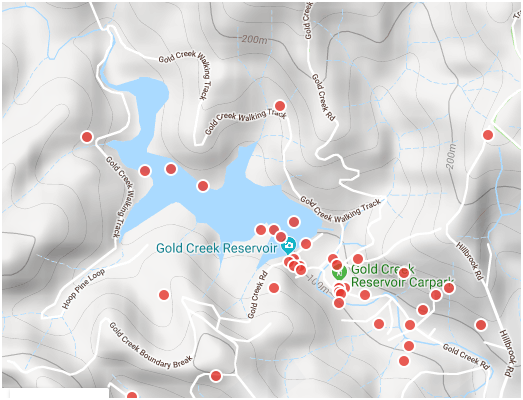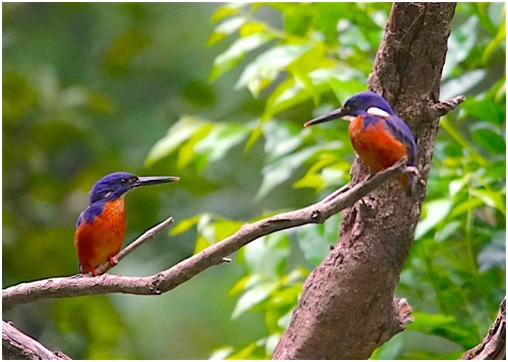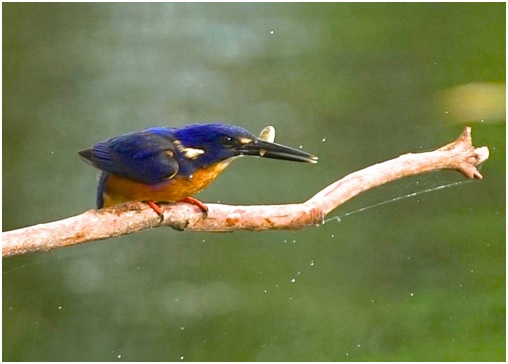In my last Bush Bites article I shared my love of birds and discussed the diversity of birdlife in Deerhurst Park, an area of parkland which runs between Brookfield Road and Gap Creek Road in Brookfield.
In this article I will introduce you to another amazing birding site within our catchment: Gold Creek Reservoir, an entry point to an extensive network of trails that lead as far as Lake Manchester and the Enoggera Reservoir. Gold Creek Dam is managed by SEQ Water.
BIRDING SITE #2: GOLD CREEK RESERVOIR
This birding site is registered with Australia|eBird (ebird.org/region/AU?yr=all) as: GOLD CREEK RESERVOIR: Latitude: -27.4628622 and Longitude: 152.883352.
The Gold Creek Reservoir is an eBird “Hotspot”. The eBird site has received 1100 checklists submitted by birders who have visited the site over the years!
When overseas birders visit Brisbane, most would visit the Gold Creek Dam. You are encouraged to submit checklists for all visits you make. Contact me to learn how!
Where is the site?
The address of the site is: 6810 Gold Creek Rd, Brookfield QLD 4069.
This is the western end of Gold Creek Road. To get there by car go to the end of Brookfield Rd at the Brookfield Show Ground, where it meets Gold Creek Rd at the roundabout. Then drive west to the end of Gold Creek Rd. The Dam is about a 15-minute drive from Kenmore Village.
Where to look for birds?
1. Main Tracks
The bushland surrounding the Gold Creek Dam is part of Brisbane Forest Park. There is a designated walking trail around Gold Creek Reservoir, in addition to the extensive fire-trail network on the hills.
The 4.5km Gold Creek Walking Track circumnavigates the Reservoir and it is an excellent way to enter all the divergent habitats there. The start of the walking track is found at both ends of the dam wall, walk clockwise or anticlockwise!
The Gold Creek Walking Track traverses grassland habitats, tall eucalypt forests, riparian zones and rainforest microhabitats in the protected gullies and good views can be had of the birds on the water at particular points.
It is a moderately difficult trail. If there is the chance to go birding for the whole day then the Reservoir tracks are the entry point into one of the most significant trail networks on Brisbane’s doorstep. Gold Creek tracks connect to longer tracks that lead to the birds at Lake Manchester and at the Enoggera Reservoir.

| Map of Gold Creek Reservoir Reproduced with the Permission of BirdLife Australia. The red dots mark the points where birds have been identified and checklists have been submitted to Birdata. Gold Creek Road enters the mapped area from the South-East corner. |
2. Picnic Area and Dam Wall
The picnic area, the carpark, the dam wall, the spillway and the bridge are all great areas to go birding! There are excellent forest birds in each of these areas. From the top of the dam wall almost the entire surface of the reservoir can be observed. A spotting telescope is required to identify the birds at the extreme edges of the water in the reservoir.
3. Gold Creek Road leading to the Carpark
There are significant habitats, mainly riparian, that are accessible by walking the last kilometre of Gold Creek Road. Park your car and then enjoy a very pleasant careful walk back along the road – very rewarding!
Who can visit the site?
The dam and recreation facilities are open to the public seven days a week from 5:30am to 6:30pm (September – April) and 6:00am to 5:30pm (May – August). As well as birders, the area is enjoyed by people who walk, run, mountain- bike and horse-ride on the many kilometres of well-maintained tracks and fire-trails. There is no swimming, boating, fishing or camping allowed at Gold Creek Dam.
What is the site like?
The site is large and beautiful and of historical significance. There is no wheelchair access. There are tables and toilets in the picnic area. The Moggill Creek Catchment Group has a prolific plant nursery there and has use as a meeting place of the now unoccupied Dam Supervisor’s House on the hill overlooking the dam.
What birds are found there?
More than 200 bird species have been observed in and on the water, in the sky and in the surrounding bush at the Reservoir. The high species count is due to the large number of habitats. The large water body adds a significant number of habitats that attract selective water species.
Gold Creek Dam is particularly valued for its role as an aquatic ecosystem. The different ecological features of a particular type of habitat determine the specific bird species that can flourish in that habitat. The more numerous and diverse the habitats are, the larger the number of bird species. The species list contains aquatic and forest residents, summer migrants, winter migrants, nomads and vagrants.
In the whole of the Moggill Creek Catchment, the Reservoir is the largest body of still water open to public access. The full list of birds can be found on the eBird site or by emailing Jim Butler at [email protected]
Special bird?
The most accessible and reliable special bird at the Gold Creek Reservoir is the Azure Kingfisher. It is often seen from the bridge over the creek in the picnic area and is the start of the track up the dam wall. The Azure Kingfisher is a common resident so it can be found at most times of the year. It is a real water-kingfisher and it forages by plunge-diving to prey on fish and other water species.
 |
© Ed Frazer |
The Azure Kingfisher is most often seen perched on a horizontal branch about 1-2 meters above the water surface. It can remain in that position for a long time so to find one takes careful observations up and down the creek from the bridge.
 |
© Ed Frazer |
| Note: In this image, the white specks are water droplets sprayed out by the kingfisher as it flicks the fish. |

